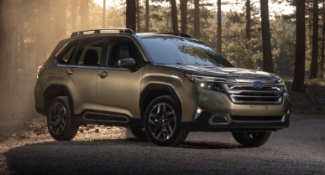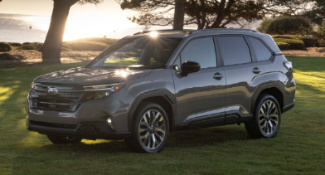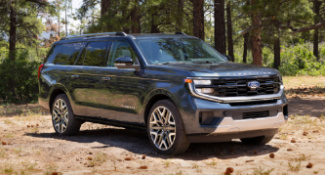Quick Facts:
Pros:
- Standard all-wheel drive on all models.
- First-rate standard safety package.
- Excellent fuel efficiency.
- Spacious cargo area and comfortable seating.
Cons:
- Underpowered drivetrain, with no upgrade option.
- Plain styling.
- Poor predicted reliability rating.
Vehicle Type: A four-door, five-seat compact SUV.
Price Range: $24,495 - $34,595 before options.
Powertrain: 182-horsepower, 2.5-liter, four-cylinder engine with symmetrical all-wheel-drive and a continuously variable transmission.
More Photos
See more 2020 Subaru Forester photos here.
Overview:
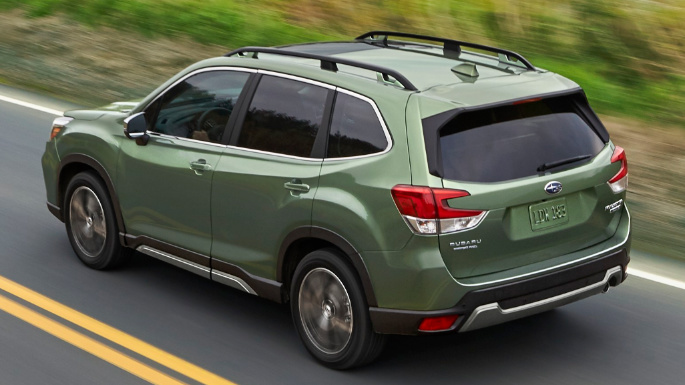
The Subaru Forester is a compact crossover SUV that has historically been oriented towards utility over high-end performance and provides the feel of a small sport utility vehicle. This vehicle caters to the value-conscious family driver and upholds the Forester reputation of safety and reliability.
The Forester is the middle brother of the midsize crossover Subaru Outback and the compact Crosstrek hatchback. The 2020 Subaru Forester is the second model of the fifth-generation that was redesigned for 2019
The 2020 Forester comes with a plethora of safety features, a standard all-wheel-drive system, and fuel economy at the top of the non-hybrid class at 26 mpg city and 33 mpg highway. The Forester offers five seats in two rows with plenty of legroom, wide-opening doors for easy entry and exit, and a wide hatch that opens to expose plenty of cargo space. The back seat folds down to maximize cargo storage to 76 cubic feet.
The Forester’s main competitors are the Honda CR-V, Toyota RAV4, Ford Escape, Chevy Equinox, Hyundai Tucson, Jeep Cherokee and Compass, Kia Sportage, Nissan Rogue, and Mazda CX-5. The advantages of the Forester are all the features that come standard on the base model while still selling for one of the lowest prices in its segment.
Although largely unchanged from the 2019 model, price bumps occur across all trim levels with the additions of automatic lane centering and lane-departure prevention to Subaru’s EyeSight safety suite.
It’s a practical and functional vehicle for families and adventurers, although it lacks an exciting driving experience. Its standard all-wheel-drive and 8.7 inches of ground clearance allows for this vehicle to conquer any terrain even with the underpowered 182-hp, four-cylinder engine.
The Forester model has long been a top-selling SUV and was introduced in 1997. The first generation carried through 2002 and included standard cruise control while carrying three engine options.
The second generation spanned 2003 to 2008 and introduced alloy wheels and a hefty eight engine options while improving rear suspension, brakes, and steering wheel for off-road effectiveness.
The third generation was the longest-produced Forester, running from 2008 to 2014. This model added creature comforts like Bluetooth, touchscreen navigation, and surround-sound and offered two engine options and two transmission options.
The fourth-generation was produced from 2014 to 2018 added an X-MODE AWD control system, which connected the engine, transmission, and dynamic control for a more seamless driving experience.
The current generation is the first to have only one engine option; it makes up for the underwhelming drivetrain with safety features like DriverFocus and additions to EyeSight Driver Assist technology. The new generation also grew to increase interior room, trunk space, and comfort, making this generation of Forester their most desirable models.
Overall Score: 7.6/10
Safety Features: 9/10
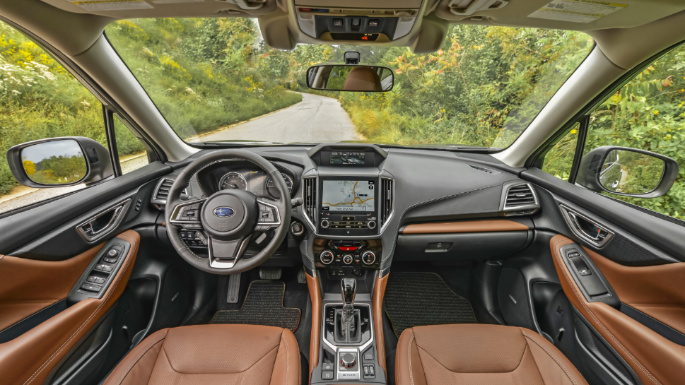
All 2020 Forester models come standard with a suite of active safety features called Eyesight Driver Assist Technology. This includes adaptive cruise control, pre-collision braking, lane departure and sway warning, and lane-departure prevention.
The Premium trim and up gain Starlink Safety and Security services with the additional option of blind-spot detection, lane-change assist, and rear cross-traffic alert. While the Sport trim adds high beam assist, and the Touring trim comes with Subaru’s DriverFocus Distraction Mitigation System, which alerts the driver when their attention has been diverted from the road.
The 2020 Forester received five-star ratings for frontal and side crash tests and received a four-star rating for the rollover test resulting in an overall safety rating of five out of five stars from the National Highway Traffic Safety Administration.
The independent Insurance Institute for Highway Safety (IIHS) designated the 2020 Forester as a 2020 Top Safety Pick (its second-highest rating). The agency gave its highest “Good” rating in all categories of crash safety, while in the crash avoidance category, the IIHS gave the Forester its highest rating in every category except for headlights.
Value: 8/10
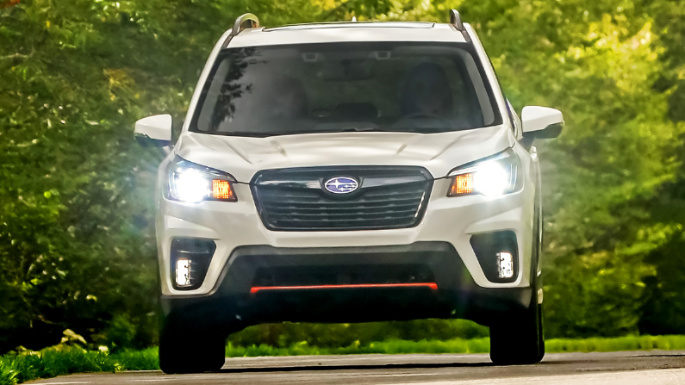
The Forester has been long hailed for its combination of affordability, features, and practicality. It is frequently among top safety picks in the segment and has long offered a strong value for the money. The 2019 Forester was awarded the IIHS Top Safety Pick and ALG Residual Value Award. The 2020 model continues to build on those accolades.
Five trim levels give buyers a lot of options. The Standard trim comes equipped with most safety features (a step up at Sport and another step at Touring), although there are no options for engine upgrades.
Impressive standard features include all-wheel-drive, rear-seat reminder, and the EyeSight safety package, which includes adaptive cruise control, pre-collision braking, lane-departure and sway warning, and lane-departure prevention.
Although the jump from the Standard to Premium trim comes at a price (a $2,900 increase), the features added are worth the extra cash. Stepping up from Standard to Premium adds Starlink safety and security, and hill descent control, bumps the sound system up from four to six speakers, adds alloy wheels, heated front seats and 4G LTE Wi-Fi capability. Additional options include dual second-row USB ports, keyless push-button start, power rear gate, blind-spot monitoring, and lane-change assist.
Tech Features: 7/10
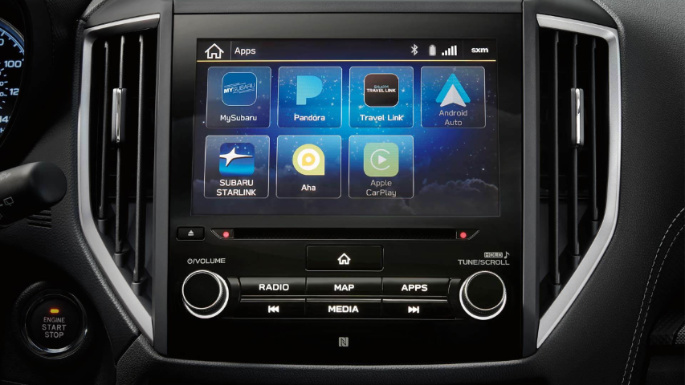
The base equipment package of the Forester is impressive as all models come equipped with Eyesight Driver Assistance Technology, which includes pre-collision braking, lane centering, and lane departure prevention. A six-and-a-half-inch infotainment touch screen that integrates with Apple CarPlay or Android Auto provides a seamless, hands-free system to access phone features without the driver ever having to take their hands off the wheel. An upgrade to an eight-inch screen is an option at higher trims. Dual front-row USB ports come standard while dual second-row USB ports become an option on the Premium trim.
Other features added on the Premium model are 4G LTE Wi-Fi capability, as well as Starlink safety and security, which provides automatic collision and maintenance notifications, roadside assistance, monthly vehicle health reviews, and remote engine start, lock/unlock, and climate control.
On the Touring trim, Subaru has added Driver Focus Distraction Mitigation technology, which alerts the driver if their attention leaves the road.
Another new standard feature on the 2020 Forester is a rear-seat reminder, which will alert you to check the rear seat at the end of your trip if you opened one of the rear doors at the start of your trip.
Practicality: 9/10
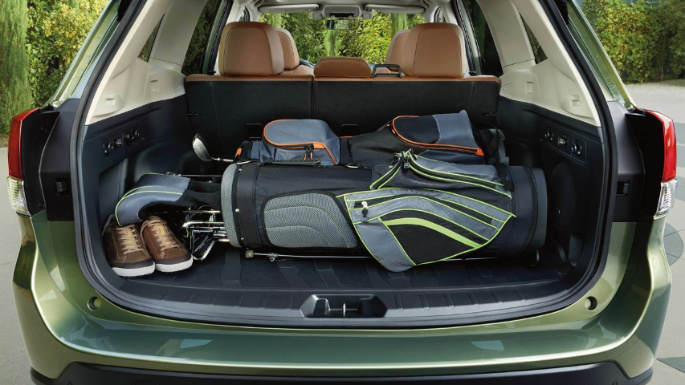
The Subaru Forester is an extremely practical daily driver for families and adventurers. The standard trim comes with all necessary safety features, provides great gas mileage, and is a smooth drive that can handle any challenging terrain.
The Forester Standard trim hails lots of storage space and a wide hatch opening for convenient packing. The cargo volume on the standard trim is 31 cubic feet with a maximum of 76 cubic feet. All higher trims have decreased cargo volume shifting to 29 and 71 cubic feet, respectively. These numbers fall slightly behind the Honda CR-V, which offers 38 cubic feet of standard storage space with 76 cubic feet.
Styling & Design: 6/10
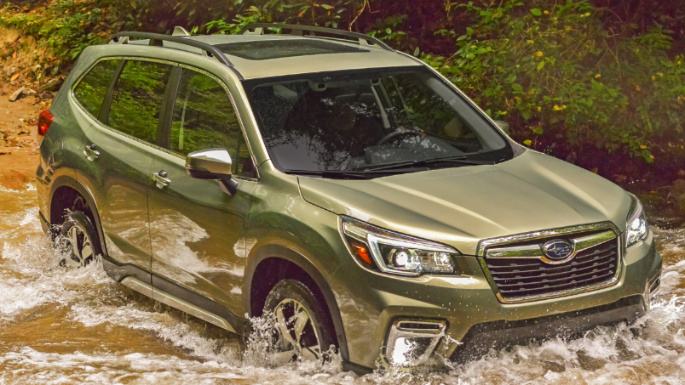
Standard and Premium models come with cloth upholstery and vinyl bolsters, while the Limited and Touring trims come with brown leather upholstery. The Sports model gets a switch to sport cloth upholstery with orange stitching and features exterior orange accents and a unique grill.
The Standard trim provides door pockets for water bottles and other items on all four doors with additional dual cup holders in the console. All higher trims also include a fold-down rear armrest with dual cup holders.
The driver’s seat on the base model is a six-way manual adjustment, while the driver’s seat on all higher trims is a ten-way power adjustment. The rear seats fold flat in a 60/40 split exposing 76 cubic feet of cargo space for the Base model. In all higher trims, the cargo space is decreased to 71 cubic feet.
The base model rides on 17-inch steel wheels, which are upgraded to alloy wheels on the Premium model. The Sport, Limited, and Touring models boast 18-inch alloy wheels in a variety of styles.
The body of the 2020 Forester is plain and standard for this model line, with no outstanding changes from the 2019 model and no significant upgrades that jump out from the pack of standard SUVs. The intention of the Forester is safety and utility over fashion and has led Subaru to leave styling gambles to other models.
Driving Experience: 6/10
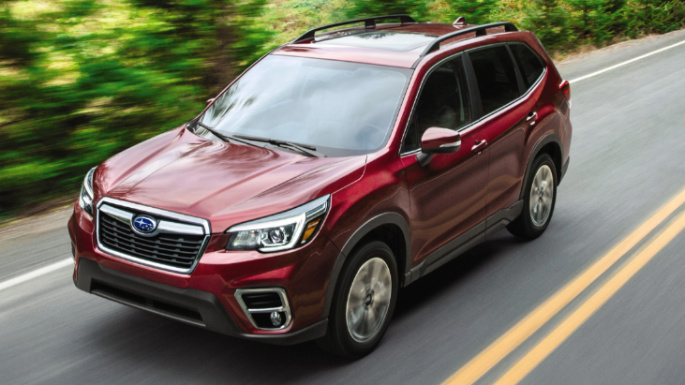
The Forester provides a relaxed driving experience that suits its class with responsive brakes and steering contributing to its overall smooth handling. The base model offers a 6-way manually adjustable driver’s seat while higher trims offer a 10-way power-adjustable driver’s seat.
The big advantages of the Forester come in the forms of fuel efficiency and off-road capability. With standard all-wheel-drive and 8.7 inches of clearance, the Forester can get your entire family to any trailhead or campsite. Additionally, equipped on the Premium trim and above have hill-descent-control and Subaru’s “X-Mode” technology, a feature that automatically optimizes engine output and transmission ratio to make the most of the vehicle’s AWD.
Driving within the city is a less inspiring experience as the Forester’s 182-hp, flat-4 engine is underpowered and can be noisy. Luckily the cab does an adequate job of muffling the noise and finding low revs for an overall comfortable driving experience.
The biggest drawback to the 2020 Subaru Forester is engine performance. With poor acceleration and the occasionally slow response from the continuously variable automatic transmission, getting up to speed on the highway can feel sluggish and leaves the gratification of thrilling performance to be desired.
Fuel Efficiency: 8/10
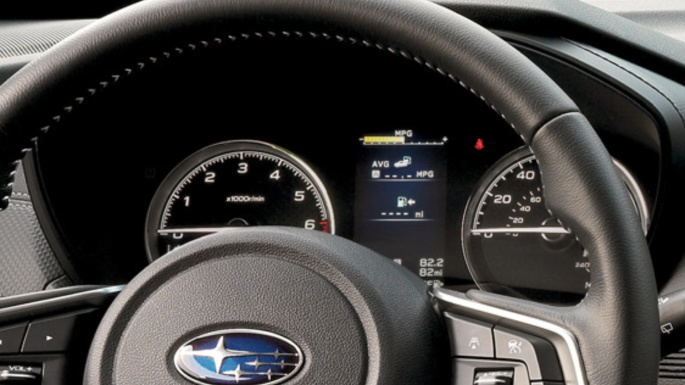
Amongst compact crossovers, the Forester is one of the most efficient non-hybrid models. It only has one engine available in the 2.5-liter, four-cylinder unit; all models are rated by the EPA at 26 mpg city and 33 mpg highway. This fuel efficiency is made more impressive by the standard all-wheel-drive capability.
The Forester’s fuel efficiency of 26 mpg city and 33mpg highway place it roughly in the middle of its competitors with the Honda CR-V rated at 28 mpg city and 34 mpg highway, the Toyota RAV4 at 26 mpg city and 35 mpg highway, the Ford Escape at 26 mpg city and 31 mpg highway, and the Mazda CX-5 at 25 mpg city and 31 mpg highway respectively.
Of its competitors, the Forester is the only model that comes standard with AWD. The Subaru Forester and Mazda CX-5 are also among the few in the segment that do not offer hybrid models.
What’s it Going to Cost Me?
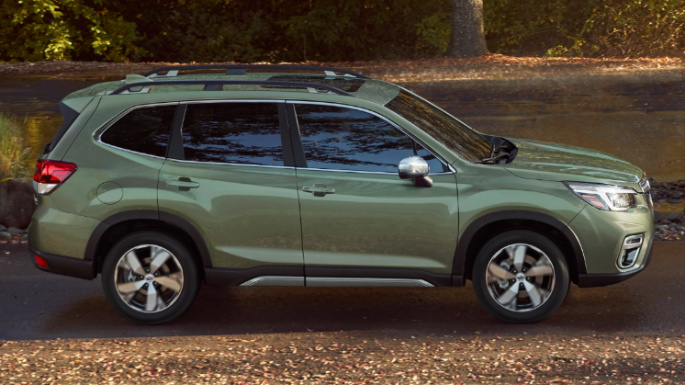
The Forester starts at MSRP $24,495 (including $1,010 destination charge) for the base Standard model with the 2.5-liter four-cylinder engine and symmetrical all-wheel drive. Standard features include four speakers, Bluetooth, Android Auto and Apple CarPlay connectivity, dual front row USB ports, a six-and-a-half inch touchscreen infotainment system, an automatic climate control system, and cloth upholstery. The storage space on this model is 31 cubic feet with a maximum of 76 cubic feet. Also standard on all models is Subaru’s EyeSight safety package, which includes adaptive cruise control, pre-collision braking, lane departure and sway warning, and lane departure prevention.
The Forester Premium trim starts at MSRP $27,395 and adds hill descent control and Subaru’s “X-Mode” technology, which optimizes engine output and transmission ratio to make the most of the vehicle’s AWD and can adapt to various terrain.
The Premium model also upgrades to six speakers, the addition of a panoramic moonroof, heated front seats, 4G LTE Wi-Fi capability, and Starlink safety and security features which includes automatic collision and maintenance notifications, roadside assistance, monthly vehicle health reviews, and remote engine start, lock/unlock, and climate control. The cargo space on this model and above decreases slightly to 29 cubic feet with 71 cubic feet.
Options include dual second-row USB ports, keyless push-button start, power rear gate, and blind-spot monitoring and lane change assist.
The Forester Sport trim starts at MSRP $28,995 and adds a sport cloth upholstery with orange stitching, CVT manual paddle shifters, high beam assist, which automatically switches lights between high and low beams when oncoming vehicles are detected, and an increase in the size of the front disc brakes.
Options include a power rear gate, a larger eight-inch infotainment system, and a Harman Kardon premium audio system with nine speakers and a 576-watt amplifier.
The Forester Limited trim starts at MSRP $31,095 and adds leather-trimmed seats, a power rear gate, dual-zone automatic climate control, and an eight-inch touch screen infotainment system. Paddle shifters are not available for this trim.
Options include a heated steering wheel and a Harman Kardon premium audio system with nine speakers and a 576-watt amplifier.
The Forester Touring trim starts at MSRP $34,595 and adds heated rear outboard seats, one-touch folding rear seatbacks, two-position driver seat and power mirror memory, a heated steering wheel, CVT manual paddle shifters, and a Harman Kardon premium audio system with nine speakers and 576-watt amplifier.
More Photos
See more 2020 Subaru Forester photos here.
